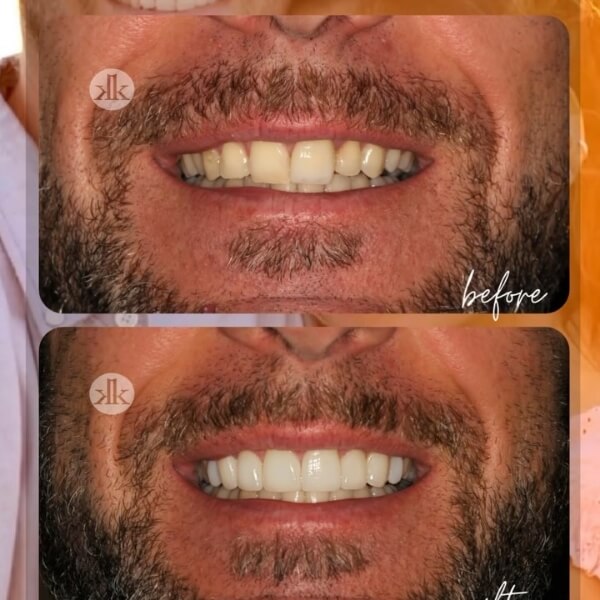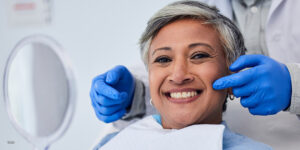
3D Digital CT Scans in San Diego, CA
When it comes to the dental care necessary to maintain a beautiful and healthy smile, having access to advanced technology can help ensure the best outcome for general and cosmetic dental treatments.
After a visual assessment, the next step in diagnosing oral health conditions or planning oral surgery is obtaining images of the teeth, soft tissues, and underlying bone.
In the past, dentists relied heavily on traditional two-dimensional (2D) X-rays to observe the teeth and jaw, but this technology can be inadequate in some situations.
La Jolla Cosmetic Dentistry is equipped with state-of-the-art technology, including a digital CT scan that offers clear three-dimensional (3D) dental imaging.
Am I a Candidate for 3D CT Scan Imaging?
Most adults are excellent candidates for imaging with a 3D CT scanner. A 3D CT scanner emits a very low dose of ionizing radiation, and side effects are rare. However, because kids are more vulnerable to potential risks, health professionals like to limit the use of CT scans in children.
Concerns may also include adverse reactions to intravenous dye that is sometimes used in other healthcare fields but not dentistry.
You should inform our staff if you are pregnant so we can take extra precautions to minimize exposure. However, the low dose of radiation is targeted toward your mouth, and your baby will not be directly exposed.
Our entire team is eager to help you improve the health of your smile and invites you to call our San Diego dental office at (858) 295-0603 to answer your questions or schedule an appointment.
-
What Techniques Are Used for 3D CT Scan Imaging?
To prepare for your examination, all jewelry, glasses, dentures, and removable metal items should be removed as they could affect the images.
The 3D digital CT scanner rotates 360 degrees, completely around your head. Instead of processing the images onto film, the machine stores the radiographs in an internal database, making them easily accessible and environmentally friendly.
Dr. Kohani can examine these images from several different perspectives to provide a precise diagnosis. For instance, if you are experiencing jaw pain, Dr. Kohani can zoom in on the digital scan and isolate the area in question. The images are viewable from every possible angle and at varying magnifications.
Patients must stay still during the 14 seconds of image collection to prevent distortion or image defects.
-
Is Digital CT Imaging Safe?
Yes, the examination procedure is considered safe. Special consideration is taken with children and patients who require multiple sets of images.
-
Why Is 3D Dental Imaging So Important in Early Detection?
As indicated earlier, 3D imaging captures issues unnoticed with 2D scans. Seeing the mouth in three dimensions can help detect problems at the earliest stages of development, meaning patients can get appropriate help much sooner.
“At our practice, we do not cut corners. We only use the most advanced, cutting-edge equipment available.”rn— Dr. Kohani
Testimonials
Our patients LOVE us, and you will too!
Dr. Kohani changed my smile by using his special veneering technique with minimal alteration of my own teeth. He is an absolute perfectionist and does unbelievable work. No one can tell I have veneers; they just notice my bright and shining smile.
I have gone to Dr. Kohani a few times now and have had nothing but great experiences. I was impressed with the friendly staff that is welcoming and organized. We all know these visits aren’t necessarily ones we look forward to, but Dr. Kohani makes this experience quite pleasant…
I was new to La Jolla, out looking for a dentist and I actually walked into Dr. Kohani’s office by mistake. Well, it was one of the best mistakes I made. My teeth needed a ton of work and Dr. Kohani did a beautiful job. I needed fillings, root canals and veneers. Dr. Kohani was able to do it all…
As an innovative leader in oral health care and cosmetic dentistry, Dr. Kohani employs the most advanced dental technology. He holds several patents and continues training in emerging dental science to improve patient care.
Providing Advanced Dental Care in San Diego, CA
As an innovative leader in oral health care and cosmetic dentistry, Dr. Kohani employs the most advanced dental technology. He holds several patents and continues training in emerging dental science to improve patient care.
To meet all your oral health needs, La Jolla Cosmetic Dentistry & Orthodontics offers the highest level of care and a wide range of dental services, some of which include:
- General dental care
- Cosmetic dental care
- Orthodontic treatment
- Dental crowns
- Dental implants, bridges, and dentures
- Periodontal (gum care) treatment
- Root canal treatment
Dr. Kohani’s ultimate goal is to use the latest, best technology, like our 3D CT scanner, to detect and correctly diagnose various oral health conditions while providing the most effective treatment options for our San Diego dentistry patients.
Patient Portal Login













